
01 Mar 2025 Spray Painting
Safety must come first in order to provide a fun and safe spray painting session. Although
spray painting is a great method to refresh furniture or give do-it-yourself projects a
distinctive touch, it can also be a risky endeavour. Important spray painting safety advice
will be covered in this article, including the use of personal protective equipment (PPE),
adequate ventilation, safeguarding your surrounds, and proper material disposal.
When spray painting, personal protective equipment (PPE) is essential for shielding your
skin, eyes, and respiratory system from dangerous fumes and particles. Choose personal
protective equipment (PPE) that fits properly and is comfortable to use. You should also
choose respirator cartridges that are suitable for the chemicals in the spray paint you're
applying.
Wearing personal protection equipment (PPE) is essential when spray painting in order to
shield your skin, eyes, and respiratory system from any potentially dangerous fumes or
particles. Gloves, a respirator, and goggles or a face shield are examples of PPE.
Make sure the PPE you choose fits properly and is comfortable to wear. Select gloves that
won't irritate your skin if it's sensitive. To protect yourself from the chemicals in the spray
paint you're using, you might also need to select a respirator with the right cartridges.
Another essential component of spray painting safety is ventilation. Any hazardous
particles or fumes that could endanger your respiratory system should be avoided. If you're
working indoors, make sure the space has adequate ventilation and move the air around
with a fan or open windows. To ensure adequate airflow, try working outside or in a garage
with the door open.
Another smart choice is to use a paint or spray booth. The ventilation system in these
enclosed areas manages overspray and keeps any dangerous gases from leaking into the
surrounding air. This is particularly helpful when using spray paint regularly or working on
huge projects.
When spray painting, it's crucial to keep your surrounds safe. Paint can go on things you
didn't plan to paint, such as walls, floors, and other items. Cover the surrounding area with
old sheets or a drop cloth to avoid any unwelcome mess. Masking tape is another tool you
can use to shield particular areas you don't want painted.
It's also crucial to work in an area that isn't too close to other possessions. For instance,
keep a piece of furniture away from other furniture and objects if you're spray painting it.
This keeps paint off of other items and avoids any unintentional overspray.
See Also: Bid Farewell to Furry Edges: The Expert Spray Painting Method Sure to Make an
Impression
It's important to properly dispose of any materials after spray painting. This covers any
remaining paint as well as the spray can. These materials should be disposed of properly
because leaving them laying around can be dangerous. Verify that you are disposing of
waste according to the correct criteria by consulting your local legislation.
Some towns require aerosol cans to be disposed of in the ordinary trash, while others have
special recycling programs. To be sure you're following the right rules, it's crucial to
confirm with your local authorities.
Find out more: Safe Aerosol Can Disposal
You can safeguard both your environment and yourself while spray painting by according
to these safety guidelines. A safe spray painting experience requires wearing personal
protection equipment, making sure there is enough ventilation, safeguarding your
surroundings, and disposing of products appropriately. Enjoy your spray painting
endeavours and always put safety first!
Contact: AK Technical Services Dubai for eco-friendly spray painting and best home
painting for your villas, apartments, and offices.Website: https://aktechnical.services/
Call Whatsapp +971-569638326 Email: info@aktechnical.services